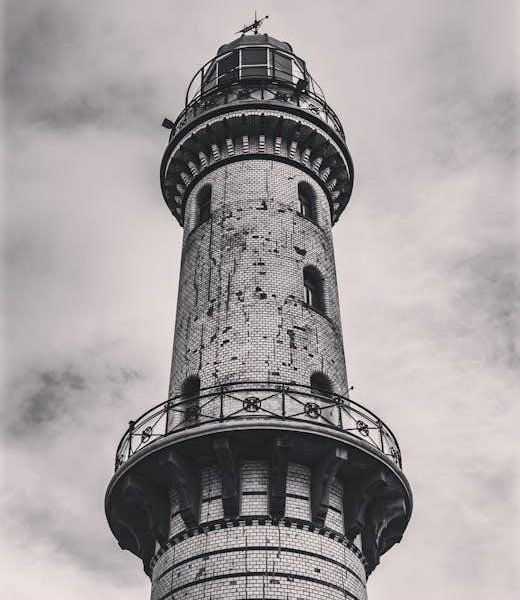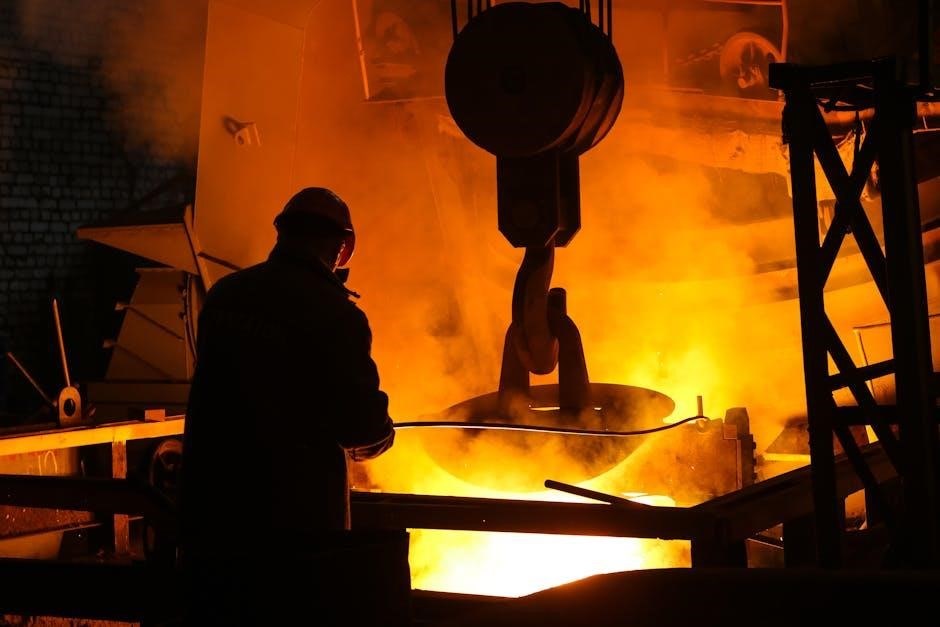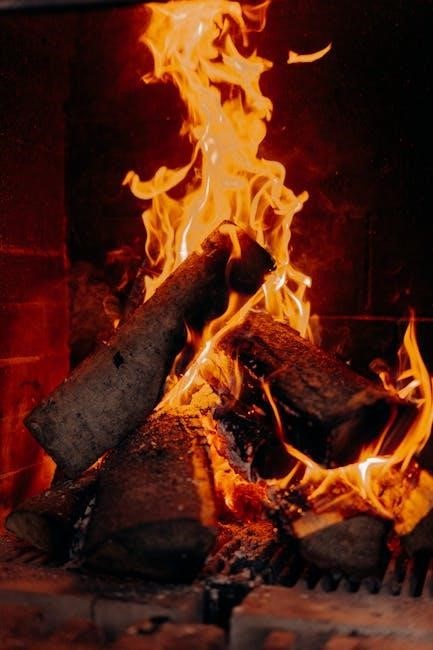
dometic furnace troubleshooting guide
The Dometic RV furnace ensures comfort and safety during cold weather. This guide provides essential troubleshooting steps, safety checks, and solutions to quickly restore reliable heating in your RV.
Understanding Dometic Furnace Components
The Dometic furnace consists of key components like the thermostat, blower motor, sail switch, igniter, burner assembly, and venting system, each playing a vital role in safe, efficient heating.
Thermostat
The thermostat is a critical component that regulates the RV’s temperature by controlling when the furnace turns on and off. It senses the room temperature and sends signals to the furnace to maintain the desired comfort level. If the thermostat is faulty, the furnace may not operate correctly, leading to inconsistent heating or complete shutdown. Common issues include wiring problems, faulty sensors, or incorrect settings. Troubleshooting steps involve checking the thermostat’s power supply, ensuring proper wiring connections, and testing its functionality by bypassing it temporarily. Regular maintenance, such as cleaning dust from the sensor, can prevent malfunctions and ensure reliable performance.
Blower Motor
The blower motor is responsible for circulating air through the furnace and into the RV’s duct system. If the blower motor fails to start or operates inconsistently, it can disrupt heating performance. Common issues include worn bearings, debris buildup, or electrical malfunctions. Strange noises, such as grinding or squealing, often indicate worn or loose parts. To troubleshoot, ensure the motor has proper power supply, check for blockages in the ducts, and inspect for loose connections. Cleaning the motor and tightening fasteners can resolve many issues. If problems persist, replacing the blower motor may be necessary to restore efficient airflow and reliable heating.
Sail Switch
The sail switch is a critical safety component that ensures proper airflow before ignition. It detects if the blower motor is operating and providing adequate ventilation. If the sail switch fails, the furnace won’t ignite, and you may hear the blower running without heat. Common issues include dirt accumulation, mechanical failure, or improper installation. To troubleshoot, clean the sail switch gently with compressed air and ensure it’s free from obstructions. If cleaning doesn’t resolve the issue, replacing the sail switch is necessary. Always refer to the owner’s manual for specific instructions, as improper handling can lead to safety hazards or further system malfunctions.
Igniter
The igniter is responsible for sparking the propane to initiate combustion. A faulty igniter can prevent the furnace from lighting, leading to no heat. Common issues include dirt buildup, wear, or electrical faults. If the igniter fails, the burner won’t ignite, and you may hear clicking sounds without flames. To troubleshoot, inspect the igniter for cleanliness and proper alignment. If damaged or worn, replace it with a compatible part. Ensure the circuit board and gas valve are functioning correctly, as they control the igniter’s operation. Always follow safety guidelines when handling electrical and gas components to avoid hazards. Refer to the owner’s manual for specific replacement instructions.
Burner Assembly
The burner assembly is where propane mixes with air to produce heat. Issues here can cause inconsistent or no heat. Common problems include clogged burner orifices, dirt buildup, or improper gas flow. If the burner doesn’t light or produces a yellow flame, it may indicate a blockage or ventilation issue. To troubleshoot, clean the burner assembly regularly and ensure proper propane supply. Check for any obstructions in the venting system, as restricted airflow can disrupt combustion. If the burner assembly is damaged, replace it with a genuine Dometic part. Always ensure the area is well-ventilated and follow safety precautions when handling gas components to prevent accidents. Regular maintenance helps maintain efficient and safe operation.
Venting System
The venting system is crucial for safely removing combustion gases from your RV. Blockages or damage can lead to ignition failure, inconsistent heating, or even dangerous gas buildup. Regularly inspect the vents for obstructions, such as debris or pests, and ensure all connections are secure. If the furnace shuts off unexpectedly, check for proper ventilation. Clean or replace vent components as needed to maintain airflow. Faulty or clogged vents can trigger safety switches, preventing the furnace from operating. Always ensure the venting system is clear and functional to avoid carbon monoxide risks and maintain efficient heating. Proper ventilation is essential for both safety and performance.

Essential Safety Checks Before Troubleshooting
Always begin with safety checks: inspect for gas leaks, ensure proper ventilation, and verify electrical connections. These steps prevent hazards and ensure efficient furnace operation and repairs.
Checking for Gas Leaks
Gas leaks are a critical safety concern. Start by turning off the propane supply and ensuring the furnace is cool. Use a gas leak detector or a soapy water solution to inspect connections and hoses for bubbles, which indicate leaks. Pay particular attention to the propane line, regulator, and burner assembly. If a leak is detected, immediately turn off the gas supply and ventilate the area. Never attempt repairs without proper tools and knowledge. Addressing gas leaks promptly prevents potential fires or explosions, ensuring a safe environment for troubleshooting and repair.
Inspecting Electrical Connections
Electrical issues are a common cause of furnace malfunctions. Begin by ensuring the power supply is stable and the circuit breaker hasn’t tripped. Inspect all wiring and connections for signs of wear, corrosion, or damage. Use a multimeter to test for voltage at the thermostat and furnace terminals. Verify that the circuit board and thermostat are functioning correctly. Loose or faulty connections can prevent the furnace from igniting or operating properly. Always disconnect power before handling internal components to avoid electrical shock. Addressing electrical issues promptly ensures safe and efficient furnace operation, minimizing the risk of further complications during troubleshooting.
Ensuring Proper Ventilation
Proper ventilation is critical for safe and efficient furnace operation. Always check the exhaust vents for blockages, such as debris or pests, which can obstruct airflow. Clearing these obstructions ensures combustion gases are safely expelled from the RV. A blocked venting system can cause the furnace to malfunction, leading to issues like ignition failure or overheating. Regularly inspect and clean the venting system, especially before the heating season. Ensure all vents are unobstructed and functioning correctly to maintain airflow and prevent safety hazards. Proper ventilation not only improves heating efficiency but also protects against potential carbon monoxide buildup, ensuring a safe and comfortable environment in your RV.
Common Issues and Symptoms
Common Dometic RV furnace issues include ignition failure, inconsistent heating, and strange noises. These symptoms often indicate underlying problems with components like the thermostat, blower, or ignition system.
Ignition Failure
Ignition failure is a common issue in Dometic RV furnaces, often caused by low propane supply, faulty igniters, or malfunctioning circuit boards. If the igniter fails to spark or the gas valve doesn’t open, the burner won’t light. This can also be due to a blocked venting system or a failed sail switch. To diagnose, check propane levels, ensure the igniter is clean, and test the circuit board for proper function. If the issue persists, replacing the igniter or gas valve may be necessary. Always ensure proper ventilation and follow safety guidelines when troubleshooting ignition-related problems.
Inconsistent Heating
Inconsistent heating in a Dometic RV furnace can stem from issues like low propane supply, a faulty thermostat, or blockages in the venting system. If the furnace cycles on and off frequently or fails to maintain a steady temperature, it may indicate a malfunctioning sail switch or a dirty burner. Additionally, improper airflow due to obstructed vents or a malfunctioning blower motor can disrupt heating performance. To resolve this, ensure propane levels are adequate, clean the burner, and inspect the venting system for blockages. Regular maintenance, such as checking electrical connections and ensuring proper airflow, can help prevent inconsistent heating and maintain reliable furnace operation.
Strange Noises
Strange noises from a Dometic RV furnace, such as rattling, clunking, or grinding sounds, often indicate mechanical issues. These noises may stem from loose components, worn-out blower bearings, or debris inside the furnace. A malfunctioning blower motor or obstructed airflow can also cause unusual sounds. To address this, inspect the blower for damage or blockages and ensure all fasteners are tightened. Regular cleaning of the furnace and its components can prevent debris buildup. If the noise persists, it may be necessary to replace worn parts, such as bearings or the blower motor, to restore quiet and efficient operation. Consistent maintenance helps avoid such issues and ensures smooth furnace performance.

Troubleshooting Steps
Start with basic checks like verifying propane levels and electrical connections. Progress to advanced diagnostics, such as testing the igniter or sail switch. Always follow a systematic approach to identify and resolve issues efficiently, ensuring safe and effective furnace operation.
Basic Checks
Begin by ensuring the propane supply is adequate, as low levels can prevent ignition. Check for blown fuses or tripped breakers in the electrical system. Verify that all electrical connections are secure and not damaged. Test the thermostat by bypassing it to see if the furnace operates normally. Ensure proper ventilation and airflow by clearing any blockages in vents or ducts. Listen for unusual noises that may indicate issues with the blower motor or igniter. These initial steps can often resolve common problems without requiring advanced diagnostics or professional assistance.
Advanced Diagnostics
For deeper issues, examine error codes on the diagnostic display, if available. Test the igniter resistance using a multimeter to ensure it’s within specifications. Inspect the gas valve for proper operation and clean or replace it if necessary. Check the high-limit switch and sail switch for continuity, as faulty switches can prevent ignition. Investigate the propane system for leaks or pressure issues using a manometer. Perform a combustion air test to ensure proper ventilation. If the blower motor isn’t functioning, test its capacitor and wiring. Advanced diagnostics may require specialized tools, so consult a professional if unsure. These steps help identify complex issues beyond basic troubleshooting.

Maintenance Tips for Optimal Performance
Regularly clean the burner and venting system to ensure proper airflow and combustion. Inspect and replace worn or damaged components promptly to maintain efficiency and safety.
Cleaning the Burner
Cleaning the burner is crucial for maintaining your Dometic RV furnace’s efficiency and safety. Start by turning off the propane supply and allowing the unit to cool. Remove the burner assembly and gently brush away dirt and debris using a soft-bristle brush or a vacuum cleaner. Inspect for any blockages or corrosion and clean the orifice holes with a small drill bit or a specialized cleaning tool. Reassemble the burner and ensure all connections are secure. Regular cleaning prevents clogs, ensures proper ignition, and reduces the risk of carbon monoxide leaks. This simple maintenance step can significantly extend the life of your furnace.
Checking the Venting System
Regularly inspecting the venting system is vital for safe and efficient operation of your Dometic RV furnace. Start by examining the exterior vent for blockages, such as nests or debris, and ensure it is securely fastened. Check the interior vent pipes for signs of damage, rust, or leaks. Use a flashlight to inspect the combustion chamber for obstructions. Ensure all connections are tight and free from gaps. A compromised venting system can lead to dangerous carbon monoxide buildup, so any issues should be addressed immediately. Cleaning and securing the vents ensures proper airflow and safe combustion, maintaining your furnace’s performance and safety.

Tools and Supplies for DIY Troubleshooting
For effective DIY troubleshooting of your Dometic RV furnace, gather essential tools and supplies. A multimeter is crucial for testing electrical connections and voltage. Screwdrivers (Phillips and flathead) are needed for disassembling components. Pliers and wrenches help with gas lines and fittings. A flashlight illuminates hard-to-reach areas, while a vacuum cleaner removes debris from vents and burners. Safety gear like gloves and goggles protects you during repairs. A propane leak detector ensures gas safety, and a fuse tester identifies electrical issues. Keep spare fuses, switches, and gaskets on hand. These tools enable safe and efficient diagnostics, helping you address common furnace problems without delay. Always refer to your owner’s manual for specific requirements.

When to Call a Professional
If you encounter complex issues beyond basic troubleshooting, it’s wise to consult a professional. This includes situations like persistent ignition failures, severe electrical malfunctions, or gas line leaks. If DIY repairs don’t resolve the problem or you’re unsure about safety, seek expert help. Professionals have the tools and expertise to address internal component failures, such as faulty circuit boards or damaged heat exchangers. Additionally, if error codes persist or you suspect propane system issues, a certified technician can ensure safe and effective repairs. Don’t risk safety—contact Dometic support or a qualified RV technician for assistance with intricate or high-risk furnace problems.

The Role of the Owner’s Manual in Troubleshooting
The owner’s manual is a vital resource for troubleshooting your Dometic RV furnace. It provides detailed diagrams, error code explanations, and step-by-step repair guidance specific to your model. By referencing the manual, you can identify components, understand safety protocols, and follow recommended diagnostic procedures. Many manuals include troubleshooting charts that help pinpoint issues quickly. They also outline when professional intervention is necessary, ensuring you don’t attempt risky repairs. Always keep the manual handy to streamline the troubleshooting process and avoid guesswork. It’s your first line of defense for maintaining your furnace’s performance and safety.

Preparing Your Furnace for Winter
Preparing your Dometic RV furnace for winter ensures reliable performance during cold months. Start by inspecting and cleaning the burner assembly and venting system to remove debris. Check the propane supply and connections for leaks or damage. Ensure the sail switch and igniter are functioning properly, as they are critical for safe ignition. Test the thermostat by setting it to a higher temperature to confirm the furnace activates. Insulate exposed ducts and pipes to prevent heat loss. Finally, perform a full system test to ensure everything operates smoothly. Regular maintenance now prevents unexpected breakdowns later, keeping your RV warm and safe all winter long.

Leveraging Online Resources and Communities
Online resources and communities are invaluable for Dometic RV furnace troubleshooting; Dometic’s official website offers service manuals, diagnostic guides, and troubleshooting charts specific to your furnace model. YouTube channels and RV forums provide step-by-step repair videos and advice from experienced RVers. Websites like Quality Home Air Care offer detailed troubleshooting tips and solutions. Engaging with these platforms helps identify obscure issues and validates DIY fixes. Additionally, Dometic’s customer support can be contacted for technical assistance. By leveraging these resources, you can resolve issues efficiently and ensure your furnace operates safely and effectively during your travels.
Regular maintenance and prompt troubleshooting are key to ensuring your Dometic RV furnace operates reliably. By following the steps outlined in this guide, you can address common issues before they escalate. Always refer to your owner’s manual for model-specific guidance and utilize online resources for additional support. Proactive care, such as annual inspections and cleaning, will extend the life of your furnace. Remember, safety should always come first—never ignore warning signs or bypass critical safety features. With proper attention, your Dometic RV furnace will provide consistent warmth and comfort, allowing you to enjoy your adventures without interruption.

Final Checklist for Dometic Furnace Maintenance
Inspect and clean the burner assembly, venting system, and blower motor regularly.
Ensure all electrical connections are secure and free from damage.
Check for gas leaks and verify propane levels before each use.
Test the thermostat and sail switch functionality.
Clear any obstructions in the venting system and ducts.
Replace the igniter or fuse if necessary.
Lubricate moving parts, such as the blower motor bearings.
Review the owner’s manual for model-specific maintenance recommendations.
Perform a full system test before the heating season begins.
Keep spare parts, such as fuses and switches, on hand.
By following this checklist, you can ensure your Dometic RV furnace operates safely and efficiently year-round.
Additional Resources and References
For further assistance, consult the official Dometic website for service manuals, troubleshooting guides, and technical support. Online forums like RV enthusiast communities and YouTube channels offer practical repair videos and advice. Websites such as qualityhomeaircare.com provide detailed troubleshooting tips and diagnostic steps. Additionally, Dometic’s customer service can be contacted for warranty inquiries and professional assistance. These resources complement the guide, ensuring comprehensive support for resolving furnace issues. Always refer to the owner’s manual for model-specific instructions and safety guidelines.
Leave a Reply
You must be logged in to post a comment.